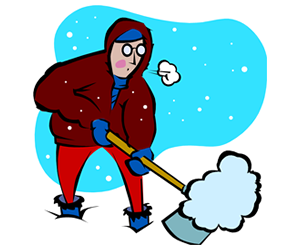Winter Protection

Now that the season is upon us and the snow has begun to fall, we all must take precautions to protect ourselves and our loved ones from the hidden hazards of winter. Often many individuals are not prepared for what ‘Old Man Winter’ blows in!
Winter hazards include increased risk of the following:
- Illnesses including the flu and the common cold
- Injuries due to accidents such as slipping or shoveling snow
- Heart injury (heart attack) for a small portion of individuals
By being prepared and following simple guidelines you can greatly decrease your risk of injury or illness this season!
Illnesses (common cold/flu)
With the cold brings more time spent indoors and around others who may be ill or sick. Without fresh air of open windows, we are constantly exposed to germs. Protect yourself this winter by following these simple guidelines:
- Avoid large indoor crowds during the cold and flu season if possible
- Wash your hands frequently throughout the day
- Avoid touching your mouth or nose with your hands
- Eat a balanced diet of protein, fruits, and vegetables to boost your immune system
- Stay hydrated with plenty of water (at least 8 glasses a day)
- Get plenty of sleep ~ aim for 7-8 hours per night
Injuries
Each year, hospitals and physicians see an increased number of individuals who have sustained injuries due to the winter season. Preventing winter injuries can be as simple as following some preventative measures.
- Research current and upcoming weather conditions prior to leaving your home
- Wear appropriate shoes and clothing for the weather including a hat and gloves
- Prepare a survival kit for your car that includes water, blankets, and food in the event that you are stranded on the road
- Ensure that your car is ready for winter including installing new windshield wipers and tires if needed
- Always have an adequate amount of gas in your car to avoid gas-line freeze up or running-out of gas in the cold
- When shoveling, take your time and avoid lifting heavy snow that could cause back strain. Take frequent breaks and work slowly.
Heart Injury (Heart Attack)
Unfortunately, snow can pose a serious risk for some individuals. Shoveling snow for 15 minutes is comparable to 15 minutes of moderate physical activity. Although we should all aim for 30 minutes of moderate physical activity on most days of the week, some do not, and therefore those individuals who are not physically active may experience more heart strain during shoveling. Researchers have reported an increase in the number of fatal heart attacks among snow shovelers after heavy snowfalls. This rise may be due to the sudden demand that shoveling places on an individual’s heart. Also, in addition to the demand the heart is experiencing, the cold air makes working and breathing hard, which adds some extra strain on the body. Those most at risk for a heart attack include:
- Anyone who already has had a heart attack
- Individuals with a history of heart disease
- Those with high blood pressure or high cholesterol levels
- Smokers
- Individuals leading a sedentary lifestyle
Before shoveling snow this winter season, be heart healthy and follow these tips to help avoid the unthinkable:
- If you are inactive and have a history of heart trouble, talk to your doctor before you take on the task of shoveling snow.
- Avoid caffeine or nicotine before beginning. (These are stimulants which may increase your heart rate and constrict your blood vessels causing extra stress on the heart).
- Warm your muscles before shoveling by walking for a few minutes or marching in place. Stretch the muscles in your arms and legs.
- Begin shoveling slowly to avoid placing a sudden demand on your heart.
- Pace yourself and take frequent breaks.
- MOST IMPORTANTLY, LISTEN TO YOUR BODY. STOP IF YOU FEEL PAIN!
Tags: cold weather, common cold, flu, heart attack, illness, injuries, winter, winter protection
